|
1.
CENTRAL AND WEST AFRICA
Demand insights
Timber markets in China are said to be oversupplied and
storage facilities at major ports like Zhangjiagang are at
full capacity. It has been reported that Zhangjiagang Port
is only accepting logs that can be transported immediately
to the importer.
The slowdown in construction in China has led to
decreased demand and while the Chinese government has
begun to address the problems in the real estate and
construction sectors the measures will take time to have an
impact.
Exports of species such as okan, beli and ovangkol are
suffering due to the weak demand in China and the market
for bubinga/kevazingo, once lucrative market with prices
in the thousands, has significantly declined.
In contrast to the downturn in demand in China there is
said to be robust demand in Vietnam, especially for tali.
The Port of Owendo in Libreville is filled with large sized
tali sawnwood with dimensions ranging from 15x15 cm to
20x30 cm and lengths of 200 to 300 cm all destined for
Vietnam.
The Philippines maintains its strong demand for species
such as okoume and dabema and order levels for Middle
East markets are good with orders placed two to three
months in advance for redwoods, okoume and andoung.
The European market remains slow overall with no
significant changes.
Regional harvesting and production
In Cameroon heavy rains are leading to transport delays
and logistical problems, particularly affecting the
movement of timber. Sawmills in Cameroon report having
secured orders for the next two months and are tending to
mill species preferred in European markets such as moabi,
douka/makore, doussie, padouk, sapelli and azobé.
The Central African Republic continues to supply logs and
sawn timber to Douala. The main species are sapelli,
iroko, sipo and doussie for which prices are good at
present.
In Gabon persistent heavy rains are delaying road
transport from the Southern and Eastern Regions where
not all roads are paved. Transportation on laterite roads in
the Central Regions like Lastourville and Makokou are
challenging, requiring two to three days for trucks to reach
their destinations. Due to weighbridge limitations in
Ndjolé trucks cannot exceed a total weight of 32 tonnes
further complicating logistics.
As in other countries in the region sawmills in Gabon are
also shifting focus to species favoured in Europe and
Vietnam such as azobé for the Netherlands and tali for
Vietnam.
A derailment in Gabonn mid month caused a four day
delay in shipments to the port.
In the Republic of Congo (Brazzaville) the Northern
Region has been experiencing heavy rain and flooding
causing transport problems from Likouala to Cameroon.
The mid and Southern Regions are also facing transport
delays due to the rain.
Production outlook
There is a noticeable shift towards European species
across West African countries due to declining demand
from China and India. Sustained demand from Vietnam
and the Philippines provides some stability with consistent
demand for specific species like tali, okoume and dabema.
The anticipated end of the rainy season in December
should alleviate some transportation challenges improving
the movement of timber to ports and markets. Operators in
the region are trying to anticipate the likely impact of the
EUDR on their businesses but this is a challenge as
nothing has been finalised as yet.
Launch of the new Bois Congo website
As part of the Support of the Private Sector Congo project
the ATIBT has created a website dedicated to the Congo
wood industry, bois-congo.org. This site is platform for all
stakeholders involved in the management, processing and
trade of sustainable Congolese tropical wood.
See: https://www.atibt.org/en/news/13554/discover-bois-congo-
the-new-internet-portal-dedicated-to-the-republic-of-congo-
forestry-sector
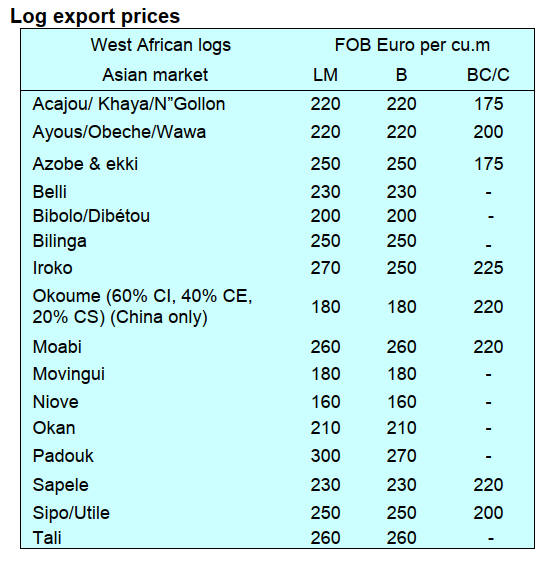
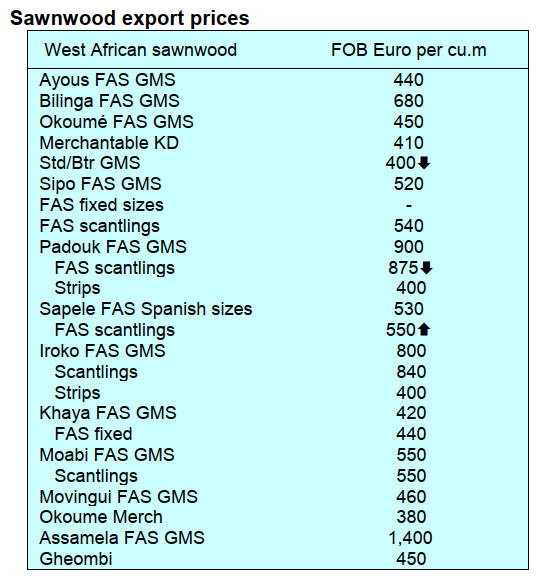
Through the eyes of industry
The latest GTI report lists the challenges identified by the private
sector in the Republic of Congo and Gabon.
See: https://www.itto-
ggsc.org/static/upload/file/20241021/1729482752156998.pdf
2.
GHANA
Kiln dried boule exports register sharp rise
Available data from the Timber Industry Development
Division (TIDD) of the Forestry Commission show that
total wood product export volumes for the period January
to August 2024 stood at 182,542 cu.m, down 10% year-
on-year. Nineteen wood products exported in the period
earned the country Eur 82.46 mil., down from Eur 92.24
mil.earned in the same period in 2023.
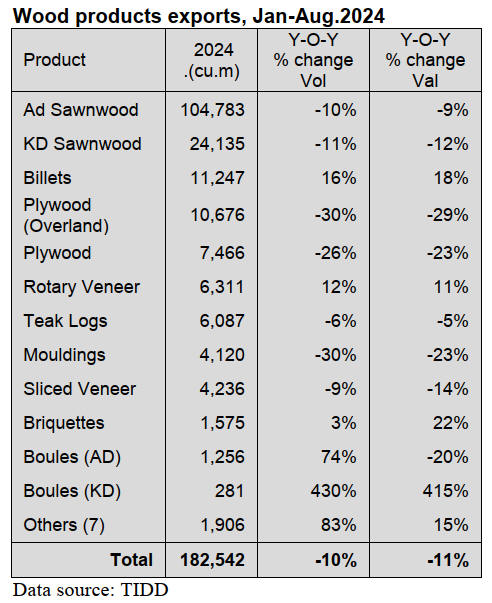
There was a sharp increase in export volumes of kiln-dried
boules (281cu.m) against the volume exported in the same
period in 2023 (53cu.m) while air-dried boule exports also
recorded a 74% growth in volume but a 20% drop in
export receipts.
Boule exports comprised niangon (78% by volume) and
sapele (22%). These were exported to France, Greece and
Italy with Smartex Timber and Plywood Company
Limited and Bright Planners Ltd. as the main exporters.
Other products that recorded positive increases in export
volumes during the period were billets (16%), rotary
veneer (12%) and briquettes (3%). These products also
recorded corresponding revenue growth year-on-year
ranging from 12% to 22%.
The TIDD report also indicated there were declines
exports in most of the major export wood products during
the 8-months period in 2024 including sawnwood,
plywood and sliced veneer compared to the previous year.
Air and kiln-dried sawnwood continued to be the leading
wood product exported from Ghana, contributing 70% and
71% of the total volume of exports in 2023 and 2024
respectively.
Farmers urged to avoid excessive felling of economic
tree species
The Forestry Research Institute of Ghana of the Council
for Scientific and Industrial Research (CSIR-FORIG) has
cautioned farmers against clearing forests for agricultural
production. The research institute has observed that a
considerable volume of commercial species were being
cut.
According to the Council, preserving forests and
enhancing carbon storage was crucial for mitigating
climate change, maintaining ecosystem health and
ensuring a sustainable future, especially in carbon trading.
Dr. Reginald T. Guuroh, Principal Investigator at the
CSIR-FORIG, made this known at the sideline of the
opening ceremony of a five-day workshop on greenhouse
gas determination in West Africa’s agricultural landscape.
See:
https://www.businessghana.com/site/news/General/314706/CSIR
-cautions-farmers-against-clearing,-cutting-tree-species-for-
agric-production
Ghana secures World Bank funding to help address
energy sector losses
Ghana has signed a US$260 million agreement with the
World Bank to help solve the US$1.2 billion energy sector
losses and inefficiencies in the sector.
The agreement, under the Energy Sector Recovery
Programme, comprises a US250 mil. credit metering
procurement package and a US$10 mil. clean cooking
grant component in line with the Bank’s Programme for
Results (PforR) initiative.
In a related development, the Co-chair of the Ghana
Extractive Industry Transparency Initiative, Dr. Steve
Manteaw, has highlighted a significant revenue increase
by the Electricity Company of Ghana (ECG). According to
him, the rise in revenue is directly linked to both private
sector participation and the full deployment of digital
infrastructure, marking a turning point for the energy
sector’s financial health.
See: https://citinewsroom.com/2024/10/ghana-inks-us260m-
world-bank-deal-to-tackle-energy-sector-inefficiencies/
Economy to grow 4.0% in 2024
According to the International Monetary Fund (IMF),
Ghana’s economy is expected to grow by at least 4% this
year up from an earlier 3% projection. Ghana’s inflation is
also expected to end 2024 at 23% according to the World
Bank’s October 2024 Africa Pulse Report. Inflation is
forecast to fall to 11.5% in 2025.
See: https://www.myjoyonline.com/imf-revises-ghanas-growth-
target-to-4-for-2024/
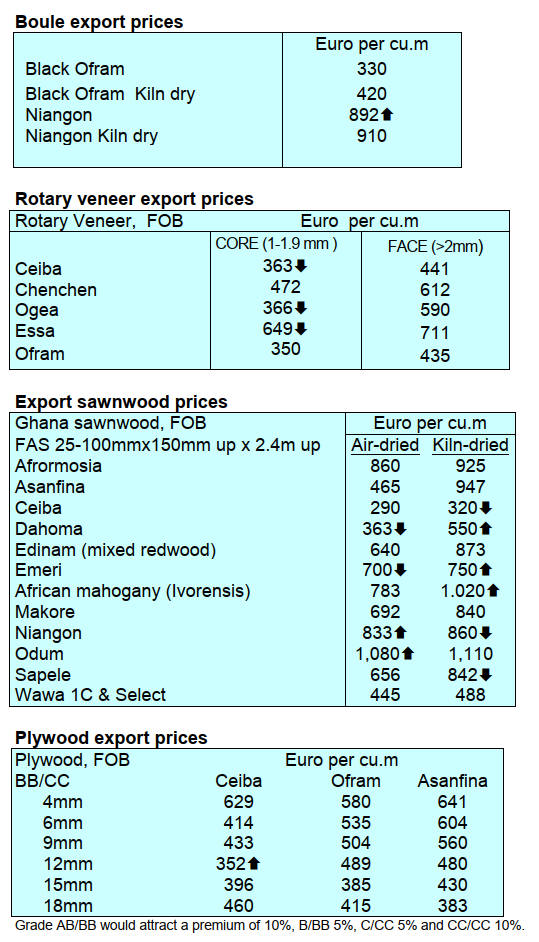
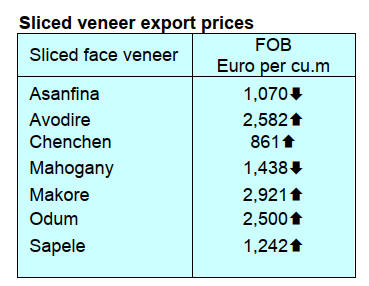
Through the eyes of industry
The latest GTI report lists the challenges identified by the private
sector in Ghana.
See: https://www.itto-
ggsc.org/static/upload/file/20240929/1727586546173092.pdf
3. MALAYSIA
Updtaed National Climate Change Policy
The Ministry of Natural Resources and Environmental
Sustainability has launched the National Climate Change
Policy (NCCP) 2.0, an updated policy that introduces a
new framework for Malaysia’s transition towards a low-
carbon economy.
The Minister, Nik Nazmi Nik Ahmad , said the NCCP 2.0
is an umbrella policy that ties together all climate
initiatives, provides a clear pathway for governance, low
carbon development, adaptation, climate financing and
partnerships as well as serves as the backbone for the
drafting of Malaysia's very own Climate Change Act,
which is expected to be completed early next year.
Nik Nazmi also hinted that driving transboundary
collaboration would be Malaysia's priority, as it assumes
the chairmanship of ASEAN next year.
See:
https://ceomorningbrief.theedgemalaysia.com/article/2024/0838/
Home/13/728468
MTIB incentives for manufacturers
The Malaysian Timber Industry Board Certification Body
(MTIB-CB) gave a briefing to explain its role and the
incentives available to manufacturers for developing
documentation based on MTIB-CB Standard Product
requirements. The MTIB-CB provides recognition for the
Timber Product Quality Assurance Scheme.
The primary objectives are to assist the local industry in
fulfilling quality assurance requirements, ensuring
consistent product quality and guaranteeing that the
certification process adheres to the developed standards
for consumer safety. Currently, MTIB-CB oversees two
product standards: the Plywood Certification Standard
(MTIB-CB-PS-01), which outlines requirements for
various plywood types and the Formaldehyde Emission
from Wood-Based Panel Standard (MTIB-CB-PS-02),
specifying emission levels for wood-based products.
See: https://sta.org.my/images/STAReviewSep2024.pdf
Technology in the forests
Huawei has developed what is termed the TECH4ALL
programme an initiative to protect biodiversity and prevent
illegal logging in Sarawak's rainforests. The project
enables forest rangers to use tracking devices from
Huawei's cloud technology and artificial intelligence.
According to Huawei Public Affairs and Communications
Manager, Atiqah Khairudin, one of the domains focused
on by Huawei at TECH4ALL in Malaysia is the
environment which sees them working closely with
partners in Sarawak to ensure that forests are protected
using technology.
"Since the implementation of this project in 2021 with the
Sarawak Forestry Corporation, Sarawak Multimedia
Authority and the Sarawak Forestry Department, 77
sounds of activity have been detected including chain saws
and vehicles in real time," he reported.
See:
https://mtc.com.my/images/media/1762/10._Teknologi_TECH4
ALL_Huawei_cegah_pembalakan_haram-
_lindungi_hutan_Sarawak_-_TVS.pdf
and
https://www.huawei.com/en/tech4all/environment
Through the eyes of industry
The latest GTI report lists the challenges identified by the private
sector in Malaysia.
See: https://www.itto-
ggsc.org/static/upload/file/20241021/1729482752156998.pdf
4.
INDONESIA
Could wood energy boom threaten SE Asian
forests
and communities?
Research presented at the recent ASEAN Summit has
warned of threats to Southeast Asia's tropical forests due
to the rapid growth of the wood-to-energy sector. The
report, ‘Unheeded Warnings: Forest Biomass Threats to
Tropical Forests in Indonesia and Southeast Asia’,
suggests energy policies push a “false climate solution”
that could result in significant deforestation.
The report, published by organisations such as Earth
Insight, Auriga Nusantara and Forest Watch Indonesia
highlights the risk of negative impacts from biomass
energy policies.
See: https://www.bioenergy-news.com/news/new-report-
highlights-biomass-threat-to-southeast-asian-forests/
and
https://en.tempo.co/read/1926703/report-wood-energy-boom-
threatens-southeast-asian-forests-and-communities
A guide for smallholders on EUDR
Indonesia, Malaysia and the European Union plan a
practical guide to the EUDR for smallholders according to
the Council of Palm Oil Producing Countries (CPOPC).
The guide will be for smallholders and small businesses in
the palm oil, coffee, rubber, timber and cocoa sectors.
CPOPC is an intergovernmental organisation for palm oil
producing countries.
Indonesia has said it fears the regulation risks driving
smallholders and SMEs out of the global supply chain.
See: https://op.europa.eu/en/publication-detail/-
/publication/13116422-7869-11ee-99ba-01aa75ed71a1
and
https://www.reuters.com/world/asia-pacific/indonesia-malaysia-
eu-work-guide-smallholders-eu-deforestation-rules-2024-10-11/
Shrinking middle class
The national statistics agency has warned Indonesia's
economy is suffering from "long COVID" in the form of a
shrinking middle class as people struggle with widespread
layoffs, rising interest rates and de-industrialisation.
The proportion of middle class Indonesians dropped from
21.4% of the 267 million population in 2019 to 17.1% of
the 289 million population in 2024, according to the
Central Statistics Agency (BPS), while the proportion of
people classified as "aspiring middle class" rose slightly
from 48.2% to 49.2%.
Those regarded as vulnerable jumped from 20.6% to
24.2% over the same period. In absolute terms the middle
class shrank by 9.5 million people.
See:
https://www.benarnews.org/english/news/indonesian/indonesias-
shrinking-middle-class-alarms-economists-
09132024151821.html
Forestry Minister - Raja Juli Antoni
The newly appointed Minister Forestry, Raja Juli Antoni,
has called on all stakeholders to collaborate in protecting
and managing forests for the benefit of the Indonesian
people.
The previous Ministry of Environment and Forestry has
been eliminated and replaced by a Ministry of Forestry
and a Ministry of Environment.
Raja Juli made this statement after receiving the handover
of office from the former Minister, Siti Nurbaya Bakar.
Raja Juli emphasised that, as Minister, he would not
merely change the name of the programme but address
challenges in the sector.
The Minister mentioned that President Prabowo Subianto
has repeatedly called for the protection of forests to ensure
that they provide benefits and welfare for all Indonesian
people.
In related news, Minister Raja Juli Antoni stated that he
will focus on resolving several forestry issues including
data transparency to address the problem of mis-allocating
of palm oil plantations in forest areas.
He specifically mentioned the issue of monitoring palm oil
governance in Indonesia, as previously expressed by the
Financial and Development Supervisory Agency (BPKP).
See: https://www.medcom.id/nasional/peristiwa/Wb7Q2ZrK-
menteri-raja-juli-antoni-ajak-semua-pihak-kolaborasi-kelola-dan-
jaga-hutan
and
https://www.antaranews.com/berita/4414433/menhut-raja-juli-
fokus-selesaikan-keterlanjuran-sawit-di-kawasan-hutan
Indonesia and UNEP establish cooperation on
environment and forestry
Before the change of government the former Ministry of
Environment and Forestry and the UN Environment
Programme (UNEP) agreed on cooperation in the fields of
environment and forestry, including the conservation and
sustainable use of natural resources.
The cooperation was founded in a memorandum of
understanding (MoU) by former Environment and
Forestry Minister, Siti Nurbaya and Regional Director of
UNEP in Asia and the Pacific, Dechen Tsering.
Dechen said that through this collaboration the UNEP will
provide support for priority programmes related to
environmental and forestry issues as well as commitments
and initiatives at the international, regional, and national
levels.
See: https://en.antaranews.com/news/329058/indonesia-unep-
establish-cooperation-in-environment-forestry
Trade Minister hoping to wrap up IEU-CEPA talks
The new Minister of Trade, Budi Santoso, has affirmed
that he will pursue the speedy conclusion of negotiations
on the Indonesia-European Union Comprehensive
Economic Partnership Agreement (IEU-CEPA).
He noted that the deadline for the completion of the
agreement has been pushed back as Indonesia and the EU
are not in agreement on several matters and it is necessary
to find solution as soon as possible.
Earlier, the Director General of International Trade
Negotiations at the Ministry of Trade, Djatmiko Bris
Witjaksono, advised that the IEU-CEPA negotiation has
stalled due to policy disagreements.
Witjaksono also described the European Union
Deforestation Regulation (EUDR) as a major stumbling
block that has prevented the two parties from finalising the
long-awaited economic agreement.
See: https://en.antaranews.com/news/330573/trade-minister-
santoso-hoping-to-wrap-up-ieu-cepa-talks-quickly
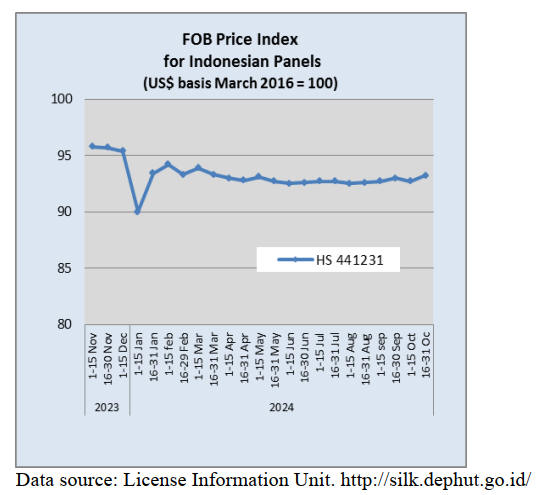
5.
MYANMAR
Conflict and natural disaster – millions need help
A press statement from the UN says “Amid escalating
hostilities in Myanmar that have plunged millions into a
deepening humanitarian crisis, UN Secretary-General
António Guterres urged the country’s neighbours “to
leverage their influence” to bring about peace.
The appeal comes as aid agencies warn that millions of
people remain in acute need across Myanmar, particularly
in the north, southeast and Rakhine state. Their plight has
been made even worse by torrential rainfall and
catastrophic flooding amid a lack of humanitarian access
and insufficient relief funding.
“The humanitarian situation is spiralling. One-third of the
population is in dire need of humanitarian assistance -
millions have been forced to flee their homes”
Guterres told a meeting of ASEAN.
See: https://news.un.org/en/story/2024/10/1155596
Meeting of the ASEAN Ministers on Agriculture and
Forestry
On 24 October the Minister for Agriculture, Forestry,
Livestock and Irrigation, U Min Naung, chaired the 45th
ASEAN Ministers on Agriculture and Forestry (AMAF)
meeting.
On the first day of the meeting representatives from
ASEAN countries, Timor-Leste, ASEAN Secretariat and
Deputy Secretary-General of ASEAN discussed progress
in the implementation of ASEAN food security,
agriculture and forestry in 2023-2024 the sustainable
agricultural programmes especially ASEAN directives on
reducing crop burning and reducing the use of dangerous
chemicals, implementation of the blue economy,
digitalisation and a joint venture of governments and the
private sector.
The ASEAN Ministers reviewed the completed tasks
mentioned in the ASEAN food security, agriculture and
forestry strategic plan and approved the 16 critical
deliverables for ASEAN food security, agriculture and the
forestry sector.
They also recorded 11 action plans and added to the
ASEAN agriculture, food security and forestry strategic
plan (2026-2030).
See: https://www.moi.gov.mm/moi%3Aeng/news/15853
Data on border trade shows decline
Exports were worth US$3.5 billion and imports were
valued at US US$3.27 billion in the first quarter of this
financial year 2024-2025 according to the Ministry of
Commerce. The data indicated a significant year on year
decline in the trade balance. Seaborne trade in the first
quarter was US$5.48 bil., down year on year from US$5.6
bil.
The border trade value declined to US$1.32 billion from
US$2.69 billion.
Myanmar exports agricultural products, animal products,
minerals, forest products, and finished industrial goods,
while it imports capital goods, intermediate goods, raw
materials imported by the CMP enterprises and consumer
goods.
See: https://www.gnlm.com.mm/myanmar-foreign-trade-shows-
surplus-in-q1/
Mandatory remittance requirements extended to cover
workers in Laos
The authorities recently extended remittance requirements
to Myanmar workers in Laos mandating that 25% of their
wages must be sent back to Myanmar through official
channels. This policy adds to existing remittance
obligations imposed on workers in Thailand.
The new regulation, enforced by Myanmar's Ministry of
Labour, requires workers to use approved remittance
channels despite concerns over unfavourable exchange
rates and high charges. This move has been met with
criticism from many sectors.
See:
https://www.rfa.org/english/myanmar/2024/10/24/myanmar-
migrant-workers-laos/)
In related news, Myanmar's humanitarian and economic
crisis has worsened under mandatory conscription.
Targeting working-age men and women this policy has
driven thousands to flee the country. The forced enlistment
comes on top of economic decline and widespread
displacements and a labour shortage is reportedly affecting
key sectors like agriculture.
It has been reported the Myanmar authorities aim to draft
5,000 people per month which has caused many young
citizens to flee the country.
Myanmar nationals, now among the top foreign property
buyers in Thailand but face growing documentation issues
due to restrictive passport renewals and forced
remittances.
See: https://eastasiaforum.org/2024/10/26/myanmar-faces-
manifold-crises-as-military-conscription-drives-mass-
exodus/?utm_source=rss&utm_medium=rss&utm_campaign=my
anmar-faces-manifold-crises-as-military-conscription-drives-
mass-exodus
6.
INDIA
Diwali – busy time for
many businesses
The week 21-25 October was the last working week before
the festive season of "Diwali" and Hindu New
Year holidays which will run until 3 November.
Businesses are often at their busiest before major holidays.
The upcoming Diwali festival, one of the most important
holidays in India, is no exception.
Diwali is one of the most important holidays in the Indian
economy, boosting consumer spending on new clothes,
gifts, home decorations, food, and beverages. As the most
celebrated holiday in the community, Diwali also leads to
increased consumer spending.
However, businesses typically close for several days
during the holiday, resulting in manufacturing delays and
inventory shortages which significantly impact the Indian
supply chain.
Shortage of affordable land holding back home
construction
In a press release, the Confederation of Real Estate
Developers' Associations of India (CREDAI) has
pinpointed two aspects that it believes would help boost
both the supply and demand for affordable housing in
India.
According to CREDAI the availability of land and the
current price cap on land for affordable housing needs to
be addressed to ensure sustained growth of the affordable
housing segment.
CREDAI asserts that the cost of land, which accounts for
nearly 50% of the total cost of any housing project, is a
huge financial burden. This is a problem for developers
especially in Tier 1 cities, where the cost of land is much
higher than other regions of the country. CREDAI believes
affordable land costs for affordable housing projects
would help and enable developers to build more houses
under the segment.
Data from the National Housing Bank reveals a 24%
increase in house prices in India since June 2018
underscoring the need for revision of the price cap on
affordable house prices.
The real estate industry advocates a re-evaluation
that
reflects current market realities and ensures adequate
availability of affordable housing units. CREDAI believes
the definition should be based on the size of the house and
not the price.
Boman Irani, President, CREDAI “Affordable Housing
has been one of the most important segments of Indian
Real Estate in the past few years, which has fulfilled the
dreams of millions of Indians to become homeowners.
Currently, there is a need to alter some fundamental
aspects to get the segment back on a robust growth
trajectory that can lead to sustained and sustainable
growth”.
See: https://www.credai.org/media/view-details/492
In other real estate news, a press release from CREDAI
says a recenta Colliers-CREDAI Report forecasts the
Indian real estate is set for 16% annual growth to propel
the market to US$10 trillion by 2047. The interplay
between real estate and India’s economic growth journey
over the next few decades is explored in the latest
report “Indian Real estate: The Quantum Leap” by
Colliers in collaboration with the Confederation of Real
Estate Developers' Associations of India (CREDAI).
The report identifies that long-term growth in real estate is
underpinned by six salient growth levers which
include rapid urbanisation, infrastructure development,
digitalisation, demographic shifts, sustainability and
investment diversification, all of which will form the
foundation for a leap in Indian real estate sector growth.
See: https://www.credai.org/media/view-details/491
Farmers - poplar and eucalyptus offer best returns
The Indian trade magazine Plyinsight has an article
reporting that in Northern India innovative farmers have
begun to plant poplar and eucalyptus which, they consider,
have potential to yield more profits than traditional agri-
crops. The wood panel industry is well-established in the
Yamunanagar Region of Haryana State of Northern India
and industries there produce about one-third of the
country’s panel products so there is a ready market for
logs.
To stimulate the promotion of agroforestry, the Punjab
government has formulated a plan that includes
establishing a consortium of government bodies ensuring
fair pricing for farm woods, creating cultivation
agreements between farmers and industries, providing
annuity payment through soft loans and developing
infrastructure.
See: https://plyinsight.com/september-edition-2024/
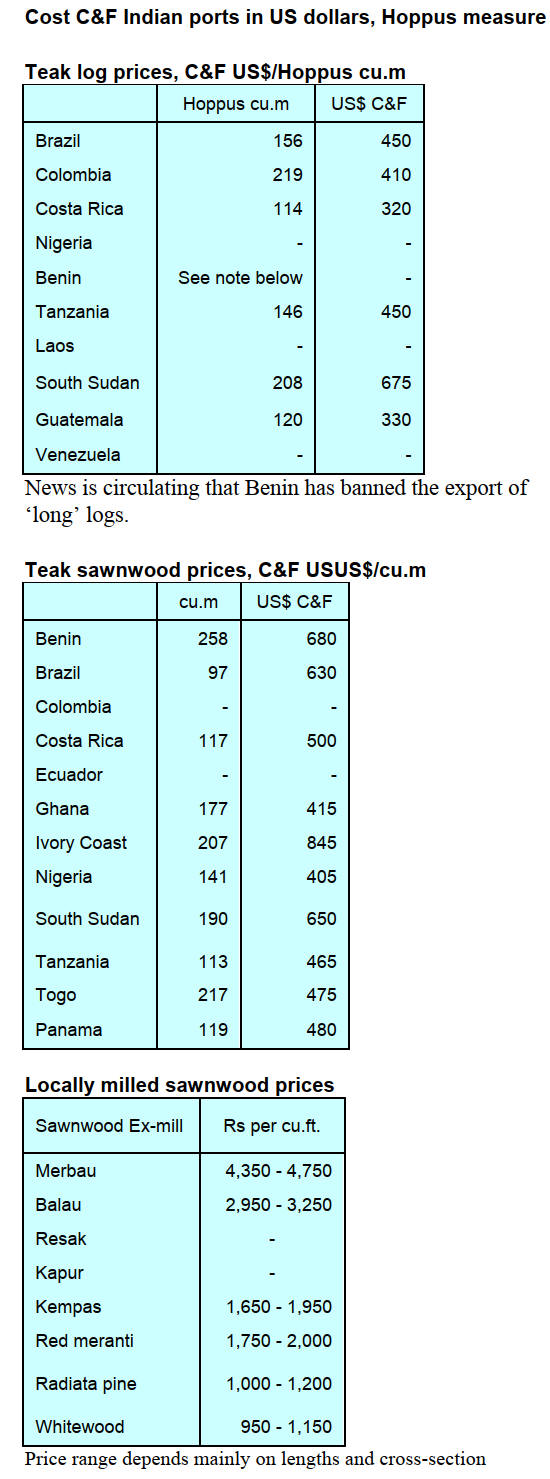 
7.
VIETNAM
Wood and wood product (W&WP) trade
highlights
According to Vietnam Customs statistic, in September
2024 W&WP exports earned US$1.25 billion, down 17%
compared to August 2024 but up 11% compared to
September 2023. The share of WP exports was US$902.5
million, down 12.5% compared to August 2024 but up
20% compared to September 2023. In the first 9 months of
2024 W&WP exports hit US$11.7 billion, up 22% over
the same period in 2023. Of this WP exports were valued
at US$8.04 billion, up 24% over the same period in 2023.
In the first 9 months of 2024 exports of wood and wood
products to the EU earned about US$378 million, up 25%
over the same period in 2023.
Vietnam's office furniture exports in September 2024
reached US$27.3 million, up 18% compared to September
2023. In the first 9 months of 2024 exports of office
furniture were valued at US$216.9 million, up 11% over
the same period in 2023.
In September 2024 W&WP imports cost US$234.5
million down 13% compared to August 2024 but up 24%
compared to September 2023. In the first 9 months of
2024 Vietnam spent US$2.03 billion on W&WP imports,
up 26% over the same period in 2023.
Vietnam's tali imports in September 2024 totalled 36,900
cu.m worth US$13.0 million, down 2% in volume and
down 2% in value compared to August 2024 but compared
to September 2023 imports increased by 18% in volume
but decreased by 2.5% in value. In the first 9 months of
2024 imports of tali were estimated 240,400 cu.m, worth
US$89.7 million, down 19% in volume and down 28% in
value over the same period in 2023.
Vietnam’s imports of logs and lumber from the US in
September 2024 surged again reaching 65,000 cu.m, with
a value of US$28.0 million, up 11% in volume and 6% in
value compared to August 2024 this represented a sharp
increase of 54% in volume and 61% in value over the
same period in 2023.
In the first 9 months of 2024 imports of logs and
sawnwood from the US reached 518,380 cu.m, with a
value of US$222.96 million, up 32% in volume and 33%
in value over the same period in 2023.
Exports of wooden upholstered chairs in September 2024
earned US$255 million, up 11% compared to September
2023. In the first 9 months of 2024 exports of this item
earned US$2.4 billion, up 22% over the same period in
2023.
Vietnam's pine imports in September 2024 were estimated
at 96,600 cu.m, worth US$22.8 million, down 14% in
volume and down 13% in value compared to August 2024
but compared to September 2023 imports increased by
12% in volume and 21% in value. In the first 9 months of
2024 imports of pine stood at 712,500 cu.m, worth
US$159.8 million, up 40% in volume and 43% in value
over the same period in 2023.
First 9 months W&WP trade
Exports
In the first 9 months of 2024 W&WP exports were valued
at US$11.7 billion, up 25% over the same period in 2023
ranking 7th among Vietnam’s export commodity groups.
In which, the WP exports shared US$8 billion, up 24%
over the same period last year, accounting for 69% of the
total W&WP exports.
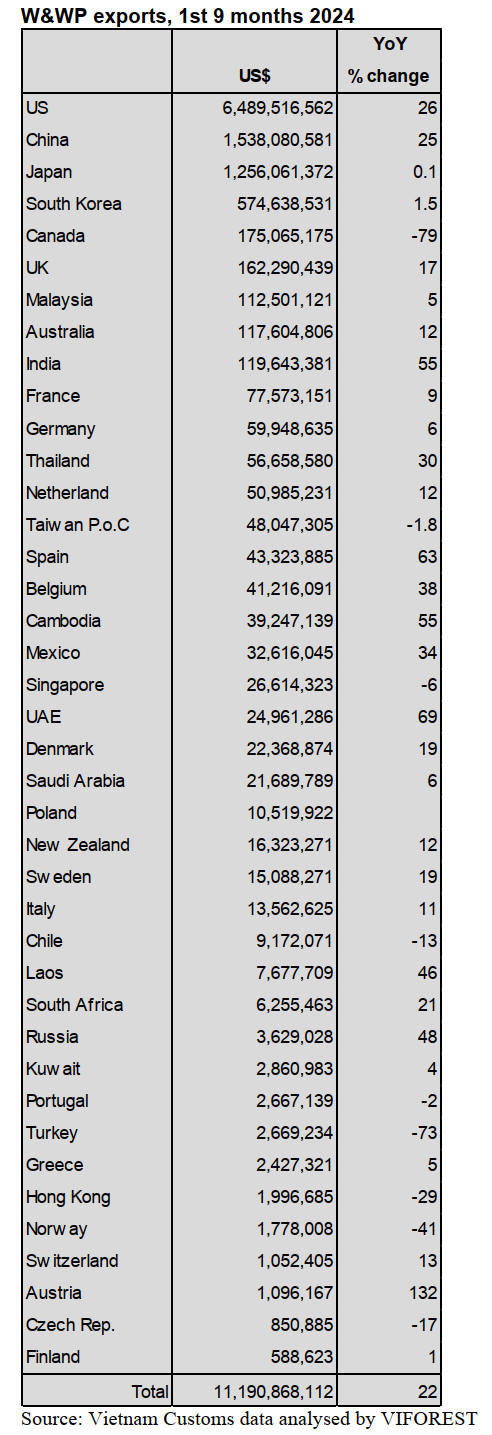 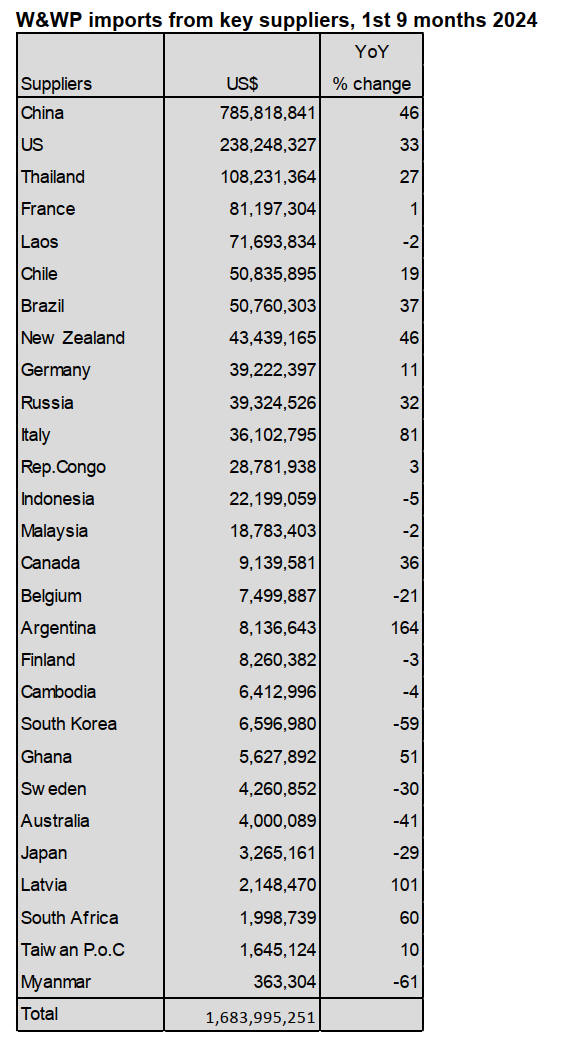
Export markets
In the first 9 months of 2024 W&WP exports to the US
and China increased sharply compared to the same period
in 2023 by 26% (US$6.5 billion) and 25% (US$1.53
billion) respectively. Exports to Japan did not increase
over the same period and exports to South Korea
decreased slightly.
On the other hand, in the first 9 months of 2024 there was
a sharp increase in exports to markets such as India, Spain,
Germany and Belgium. W&WP exports to India increased
sharply, reaching US$120 million, up 55%. India is listed
in the top 7 consumer of W&WPs exported from Vietnam.
Plywood and veneer are the main export products exported
to India.
Imports
In the first 9 months of 2024 W&WP imports amounted to
US$2.02 billion, up 26% over the same period last year.
Import by foreign (FDI) enterprises
In the first 9 months of 2024 W&WP imports by FDI
enterprises topped US$760 million, up 38% over the same
period in 2023 and accounted for 38% of the country's
total W&WP imports. The rate for the same period last
year was 27%.
Import sources
In September 2024 W&WP imports from key suppliers
decreased. Specifically, imports from China decreased by
13% (US$81), Thailand by 36% (US$10 million), Chile
dropped by 15% (US$7 million). In contrast, compared to
August 2024, imports from Brazil and the Republic of
Congo increased by 11% and 18% respectively.
In the first 9 months of 2024 W&WP imports from key
supply markets increased against the same period in 2023.
Specifically, imports from China increased by 47%
(reaching US$785 million), the US increased by 33%
(US$238 million), Thailand by 27%.
8. BRAZIL
Teak included in tax incentive programme
At the 23rd meeting of the Deliberative Council for the
Mato Grosso Development Programme
(CONDEPRODEMAT) the inclusion of teak among the
products eligible for tax benefits in the state was approved.
The State of Mato Grosso, the largest teak producer in
South America, has 68,000 hectares of planted forests.
According to CONDEPRODEMAT the inclusion of teak
in the programme will stimulate the teak sector which
stands out in the forest industry as teak products are
widely exported to Asia and Europe.
See: https://forestnews.com.br/conselho-aprova-inclusao-da-teca-
como-produto-de-madeira-para-incentivos-fiscais-em-mt/
Seeking solutions for exports amid new CITES
requirements
Representatives of Mato Grosso's forest sector took part in
meetings with the Brazilian Institute of Environment and
Renewable Natural Resources (IBAMA), the Ministry of
Agriculture and Livestock (Mapa) and the National
Confederation of Industry (CNI) to find solutions to
unblock timber exports.
The focus of the discussions was the new requirements set
by CITES on regulating exports of ipê (Handroanthus) and
cumaru (Dipteryx odorata) set to come into force at the
end of November. The meeting included participation
from the Federation of Industries of Mato Grosso
(FIEMT), the Center for Timber Producing and Exporting
Industries (CIPEM) and the National Forest-Based Forum
(FNBF).
During the meeting with IBAMA the forest sector
representatives expressed their concerns on the economic
impact of these new regulations.
IBAMA reaffirmed its commitment to applying CITES
guidelines without negatively affecting the production
sector. FIEMT also highlighted the importance of joint and
integrated action between the Federation and the
employers´ unions to find effective solutions.
With the inclusion of ipê and cumaru under CITES new
requirements and procedures for exporting these woods
have emerged. The forest sector representatives stressed
the impact of these regulations on the economic viability
of export operations. CIPEM emphasised the importance
of ongoing dialogue between the government and the
forest sector, including discussions about logistical
difficulties at the ports.
During the meeting with IBAMA's board it was agreed
that the Federal Environmental Agency will communicate
with the Ministry of Foreign Affairs detailing the
procedures for issuing CITES certificates.
IBAMA will undertake informing importing countries
about the Brazilian procedures.
See: https://cipem.org.br/noticias/setor-florestal-de-mato-grosso-
busca-em-brasilia-apoio-as-exportacoes
In related news, the CITES Secretariat has just published
an important notification concerning the implementation
of the Convention for cumaru green ebony and tabebuia.
For more information, see CITES Notification N° 2024/116.
and
See: https://cites.org/eng/node/141138
and https://www.atibt.org/en/news/13556/cites-implementation-
for-cumaru-and-green-ebony-in-brazil
Partnerships with academic institutions to boost
innovative forest management
The Center for Timber Producing and Exporting Industries
of Mato Grosso State (CIPEM) has established
partnerships with academic institutions to enhance and
strengthen native wood production in the State.
Over the past two years 12 initiatives have been
implemented including the 1st Meeting of Amazon Native
Tree Identifiers which brought together experts to
exchange experiences on timber species essential for the
sustainable forest management in the region.
Other projects include studies on energy, potential of
wood residues, converting sawdust into fertiliser,
developing forest management software and creating a
system to identify timber species in the Amazon.
Currently, more than 5 million hectares of natural forests
are under sustainable management plans in Mato Grosso
with the potential to expand this to over 6 million hectares.
According to the Brazilian Institute of Geography and
Statistics (IBGE), the state of Mato Grosso is the second
largest producer of roundwood from natural forests in
Brazil, with a production of 2.1 million cubic metres
(R$498.1 million) in 2023 representing 76 % of the total
value of harvesting in the State. Together, Mato Grosso
and Pará States account for 63% of harvests in natural
forests.
Of the State’s trade balance timber is among the ten most
traded products adding up to US$78.2 million in the first 8
months of 2024.
See: https://cipem.org.br/noticias/pesquisa-parcerias-com-
instituicoes-academicas-fortalecem-gestao-florestal
Export Update
In September 2024 the total Brazilian exports of wood-
based products (except pulp and paper) increased 20% in
value compared to September 2023, from US$260.9
million to US$ 313.5 million.
Pine sawnwood exports increased almost 10% in value
between September 2023 (US$41.4 million) and
September 2024 (US$45.3 million). In volume, exports
increased 5% from 182,000 cu.m (September 2023) to
190,900 cu.m (September 2024).
Tropical sawnwood exports increased 12% in volume,
from 23,000 cu.m in September 2023 to 25,700 cu.m in
September 2024, however, export earnings decreased 2%
from US$10.2 million to US$10.0 million over the same
period.
Pine plywood exports decreased 40% in value in
September 2024 (US$48.5 million) compared to
September 2023 (US$68.0 million). In volume terms
exports increased 32% over the same period, from 153,400
cu.m (September 2023) to 202,900 cu.m. (September
2024).
As for tropical plywood, exports increased 33% in value
and 35% in volume, from US$1.2 million and 2,000 cu.m
in September 2023 to US$1.6 million and 2,700 cu.m in
September 2024.
The value of wooden furniture exports increased from
US$47.1 million in September 2023 to US$51.0 million in
September 2024, an increase of 8%.
SFB Funds Forest Bioeconomy Projects in the Amazon
and Caatinga biomes
The Brazilian Forest Service (SFB) held meetings with
Civil Society Organizations (CSOs) in early October to
present a Public Call for proposals from the National
Forest Development Fund (FNDF).
The call, in line with the Regulatory Framework for Civil
Society Organizations (MROSC), providesthe opportunity
for support ranging from R$350,000 to R$500,000 for
projects in the Amazon and R$200,000 to R$400,000 for
projects in the Caatinga biome.
Projects should have a three-year duration and focus on
themes such as forest management, native vegetation
restoration, environmental services and development of
Value Chains. The final results of the call for proposals are
expected to be released in early November of this year.
The National Forest Development Fund (FNDF), managed
by SFB, aims to promote the development of sustainable
forest activities in Brazil and foster technological
innovation in the forest sector.
See: https://www.gov.br/florestal/pt-
br/assuntos/noticias/2024/setembro/sfb-faz-reuniao-aberta-para-
detalhar-edital-de-chamamento-sobre-bioeconomia-florestal
Brazil creates global fund for tropical forest
preservation
Brazil has launched a billion-dollar fund for tropical forest
preservation called the Tropical Forest Finance Facility
(TFFF) with operations expected to begin after the
UNFCCC COP 30 in 2025 which will be held in Brazil.
The fund aims to raise US$25 billion to finance the
conservation of 1 billion hectares of tropical forests
worldwide focusing on key biomes that are essential for
the global climate and biodiversity. The initiative will also
feature a satellite monitoring system to ensure
transparency and effectiveness in forest preservation.
During a meeting of the Finance Track (which addresses
strategic macroeconomic issues and is led by finance
ministers and Central Bank Governors of G20 member
countries) the Brazilian government emphasissed the
importance of international participation in the project
stressing that the fund was designed to attract the
engagement of developed countries.
The fund, considered as an innovative tool in climate
finance, aims to attract international engagement and boost
the market for green, blue (related to water resource
conservation) and sustainable bonds, promoting a
mechanism of mutual benefits for wealthy countries that
preserve their tropical forests.
The TFFF is expected to be officially presented at
UNFCCC COP29 in Azerbaijan in November 2024.
See: https://www.g20.org/pt-br/noticias/brasil-cria-fundo-
bilionario-para-preservacao-de-florestas-tropicais
Through the eyes of industry
The latest GTI report lists the challenges identified by the private
sector in Brazil.
See: https://www.itto-
ggsc.org/static/upload/file/20241021/1729482752156998.pdf
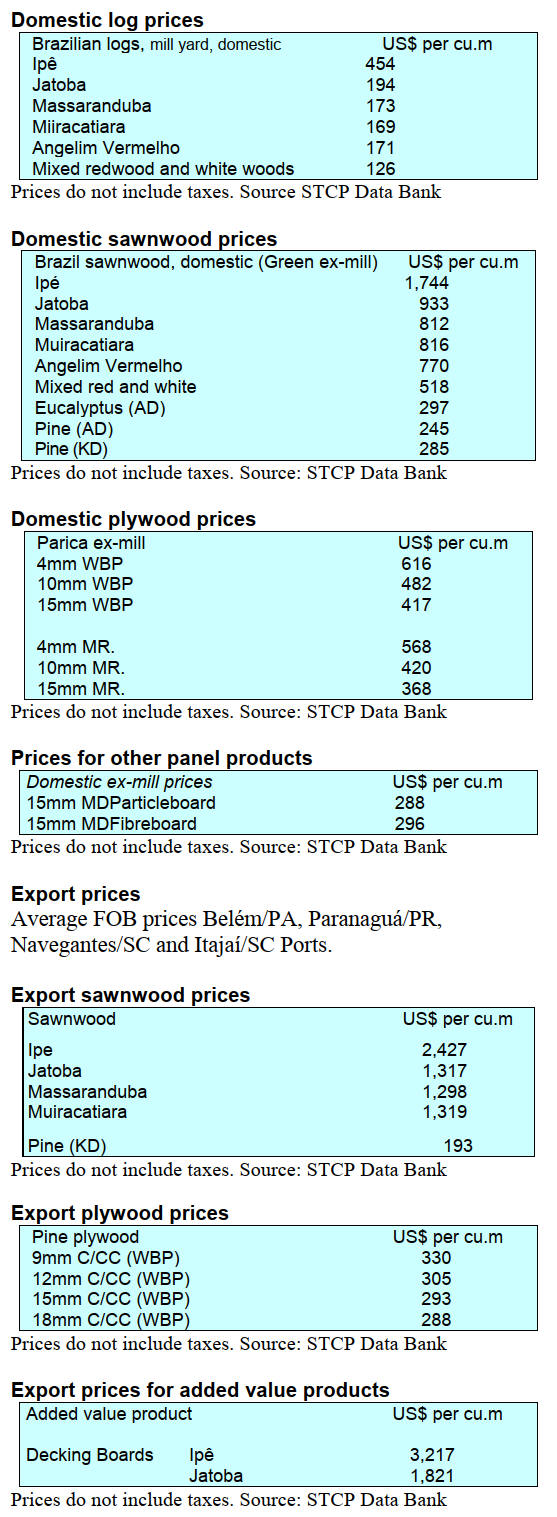
9. PERU
Plywood shipments
declined in first eight months of
the year
Between January and August 2024 plywood exports
earned US$1.80 million which represented a year on year
decline of 3.5% as reported by the Services and Extractive
Industries Management of the Exporters Association
(ADEX).
The main market for veneer and plywood in the first eight
months was Mexico, with a share of 84% but down year
on year by almost 5%. The second market was Ecuador
with a share of 12% up significantly on the same period in
2023.
Progress in addressing illegal logging
During a bilateral meeting with representatives of the
United States to assess the implementation of the Forest
Sector Management of the Trade Promotion Agreement
between the two countries the Forest and Wildlife
Resources Oversight Agency (OSINFOR) presented
progress and results from the contribution of this initiative
to the governance of the sector and the fight against illegal
logging.
OSINFOR highlighted the achievements made in the last
decade with the support of the United States. The on-going
initiative, supported by academia and international
experts, incorporates cutting-edge technology such as
high-resolution satellite images, selective logging
detection algorithms and the use of drones.
The results are evident from the lower number of forest
law infringements from 32% in 2015 to 1% in 2023 while
the volume of illegal wood seized dropped. This
significant progress has been made possible by the
expansion of supervision coverage in forested areas and
the optimisation of resources.
In its role as the Technical Secretariat of the Permanent
Multisectoral Commission to Combat Illegal Logging
(CMLTI), OSINFOR promoted the implementation of a
methodology to measure illegal logging which showed a
reduction from 37% to 20% in the period 2017-2021.
Progress in combating illegal logging was strengthened
with the approval in 2021 of the New National
Multisectoral Strategy to Combat Illegal Logging.
See: https://www.gob.pe/institucion/osinfor/noticias/1046700-en-
encuentro-peru-estados-unidos-se-presentan-avances-en-la-
lucha-contra-la-tala-ilegal
Capacity prosecutors strengthened to confront illegal
timber trafficking
In order to strengthen the fight against illegal timber
trafficking and promote inter-institutional cooperation the
Agency for the Supervision of Forest and Wildlife
Resources (OSINFOR), with the technical and financial
support of the United Nations Office on Drugs and Crime
(UNODC) and the Federal Ministry for Economic
Cooperation and Development of Germany (BMZ),
organised a workshop for justice department professionals.
The event included presentations and roundtables where
critical issues such as inter-institutional cooperation and
the role of civil society in reporting and preventing timber
trafficking were discussed.
This workshop contributed to strengthening the capacities
of justice system operators and other entities with related
responsibilities.
See: https://www.gob.pe/institucion/osinfor/noticias/1045478-
fiscales-y-operadores-de-justicia-fortalecen-sus-capacidades-
para-hacer-frente-al-trafico-ilegal-de-madera-en-loreto
 
|